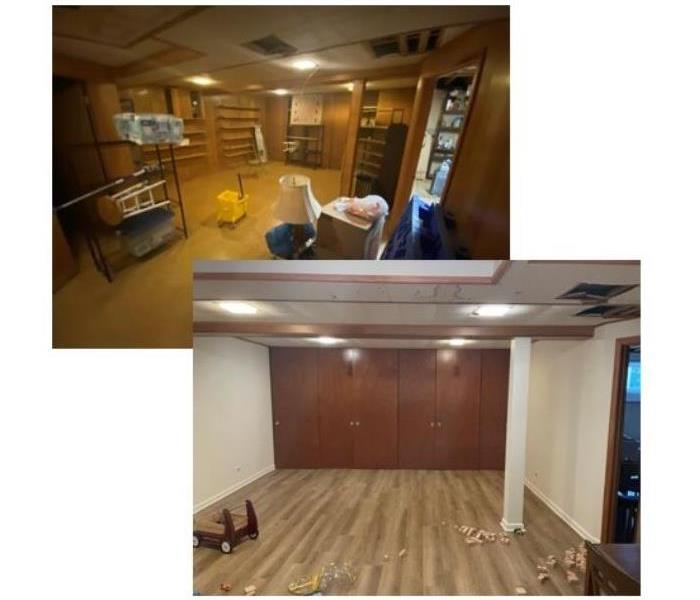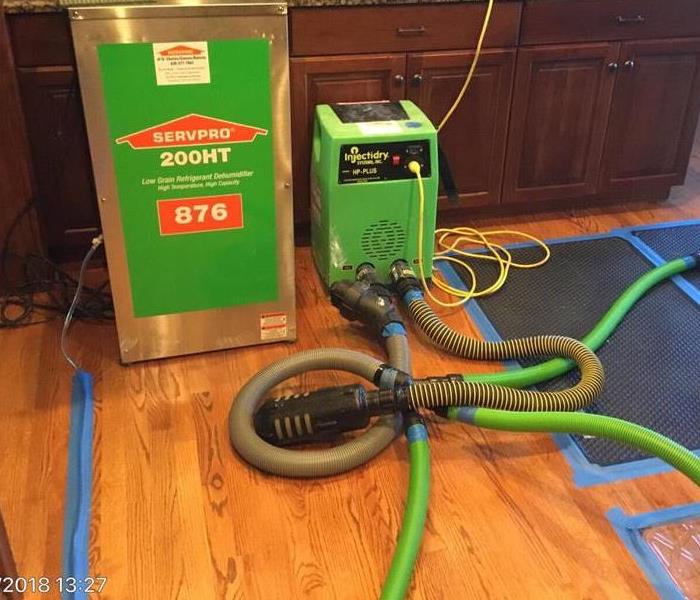Archived Water Damage Blog Posts
From Disaster to Restored!
10/27/2023 (Permalink)
From the first call to the last walk through- out our SERVPRO goal is to make water damage claims “Like It Never Even Happened.” When our office receives a call about a utility sink that has flooded a basement, we know to send our highly trained and accredited staff to accurately capture the loss and inform the insured every step of the way.
Immediately once onsite, the SERVPRO crew will begin to map out the water migration and discuss what has been affected, and how we plan to mitigation the affected materials. In this case, the standing water saturated the tile flooring and the paneling on the walls. Our team moved swiftly and effectively to move contents, remove affected materials that could not be dried, and placed adequate air movers and dehumidifiers to reach the drying goal of each material.
Once we have confirmed the water damage portion of the claim is completed, our reconstruction manager will be onsite to conduct his walkthrough and discuss how the insured envisioned this space to look after such a traumatic loss. The insured shared their vision with the team, and soon after that visit the scope was put together, insurance was informed of the process, and contractors were on site for their evaluations.
From start to finish, our team takes pride in constant communication, quality work, and standing behind any final product that we have a hand in creating. For a one stop shop, from mitigation to reconstruction, general cleanings, mold remediation, commercial cleaning services and anything in between- call the leaders in the restoration field! SERVPRO is always here to help- give us a call today! (630) 377-7062
4 Things To Do If You Have Water Leaking From Your Lights
5/20/2022 (Permalink)
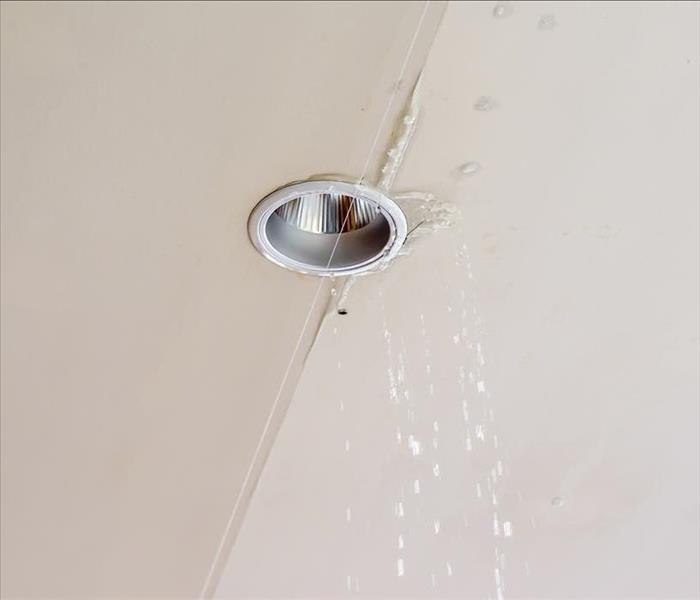 Water in light fixtures will never be on-trend.
Water in light fixtures will never be on-trend.
What To Do When Water Is Coming Out Of Your Light Fixtures
Water in light fixtures is rarely a good thing. Fortunately, it's also a fixable thing. If you spot water dripping or leaking from one of the light sources in your Sleepy Hollow, IL, home, here are the four steps you should take immediately.
1. Cut the Power
Water is an excellent conductor of electricity. That's why so many of your small appliances include that large warning label ordering you not to dry your hair in the bath or take your toaster to a water park. The moment you spot water leaking from a light, turn off power to the entire house.
2. Shut Off the Water if Necessary
Depending on the source of the leak, you may need to shut off the water to stop the problem. If you can't identify the source, shut the water off just in case.
3. Tell Everyone You Have a Water in Light Situation
If other people are at home with you, inform them that there's an emergency with the power. If company arrives, tell them, too. Make sure everyone inside the home understands that they need to steer clear of electricity sources until the issue is resolved.
4. Call a Restoration Company
Once you've minimized the potential for danger, your next step should be to call a water damage restoration company. Expect them to assess the situation and develop a plan to safely restore both power and water. If ceiling damage has already occurred, they'll address that as well.
Water in light fixtures will never be on-trend. If you spot a leak related to your home lighting, it's important to act fast. Shut off the power and water, and then place a call to the professionals. They have the equipment and know-how to return your home to normal as soon and as safely as possible.
7 Reasons To Replace Polybutylene Pipes
3/22/2022 (Permalink)
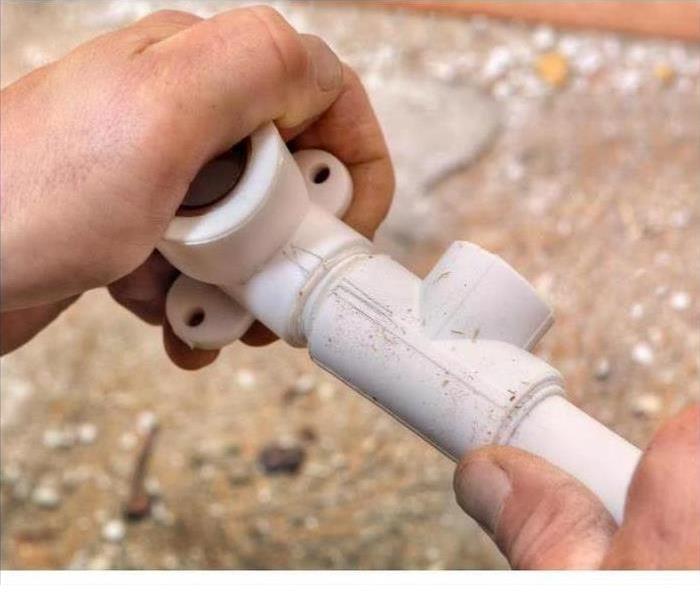 Replacing these outdated pipes will give you peace of mind and let you know your building is safe.
Replacing these outdated pipes will give you peace of mind and let you know your building is safe.
Replacing Outdated Pipes
If you have polybutylene pipes in your business, you are going to want to replace them. Even if they seem to be in good condition, there are still plenty of reasons to go with newer materials.
1. Damage
If a polybutylene pipe breaks in your wall, you are going to experience a lot of damage. Even small leaks from this type of pipe can cause damage to your flooring, walls, HVAC units, equipment, and furniture.
2. Mold
Everyone knows about the danger of asbestos in old buildings. Roofing, siding, insulation, ceilings, flooring, and structures themselves all contain this toxic material. However, mold is also a danger you have to worry about. If your building has polybutylene pipes that leak, you could wind up with mold growing in your floors, walls, and HVAC units.
3. Exterior Pipe Breaks
If a pipe breaks outside of your business, dirt under your parking lot, sidewalk, and walkways can be washed away. This can lead to cracks and be a hazard for customers and employees.
4. Utility Bills
Even the smallest leaks can cause big problems with your bills. This is especially true as the leaks worsen, and your water bill rises.
5. Water Pressure
These pipes are small and require low water pressure to avoid leaks and bursts. When you replace them, you will be able to utilize the full water pressure that you need.
6. Hot Water
When you get new plumbing installed, you won't have to worry about hot water problems anymore. This is especially great news if there are many employees in your business or you need a lot of hot water.
7. Peace of Mind
Having these pipes can leave you worrying about the safety of your building. Replacing these outdated pipes will give you peace of mind and let you know your building is safe.
There are many reasons you should consider replacing these pipes in your business in Barrington Hills, IL. In particular, it can save you from having extensive water damage that requires a remediation company to fix.
What To Do After a Flood
2/15/2022 (Permalink)
 Wood flooring was replaced after water damage.
Wood flooring was replaced after water damage.
After a Flood, What Should You Do?
Flooding from broken pipes in Gilberts, IL can cause massive amounts of damage if not cared for properly. Water damage can ruin flooring and sheetrock, leading to extensive repairs that may be expensive. The longer water is left unattended, the more damage it can cause, so the water cleanup process should be done quickly and efficiently.
Assessing the Damage
Damage from a broken pipe may be limited to a single room or, if left undetected for several days, could spread throughout an entire floor. To understand what exactly needs to be done, it is important to remove any remaining water with the help of a sump or a trash pump and then thoroughly examine the damaged area. There are two types of damage to look for:
1. Water damage. This type of destruction involves any damage to the structure of your home from the flood. It includes ruined wood flooring, carpet, sheetrock, and insulation, among other structural components.
2. Secondary damage. Unlike other types of damage, this type of problem may not be visible without a thorough investigation. Warm, moist environments can become a breeding ground for mold, mildew, and bacteria, so these fungi and pathogens thrive under wet carpet and in porous materials. In many cases, removing mold is more difficult than repairing structural damage.
Calling a Professional
Not only is repairing and restoring your home from flooding often difficult and time-consuming but fixing secondary damage often requires the help of a qualified restoration company. Household cleaning products may not be strong enough to remove mold, and thoroughly disinfecting the area is necessary for safety. Call for help quickly to reduce the amount of damage caused by flooding.
In many cases, having broken pipes is difficult to handle on your own. After assessing the damage, calling a company for the water cleanup process may be a good idea. To reduce the impact of water damage, the issue should be dealt with quickly and efficiently.
Water Dripping From Your Ceiling Fixtures - What You Should Do First
1/29/2022 (Permalink)
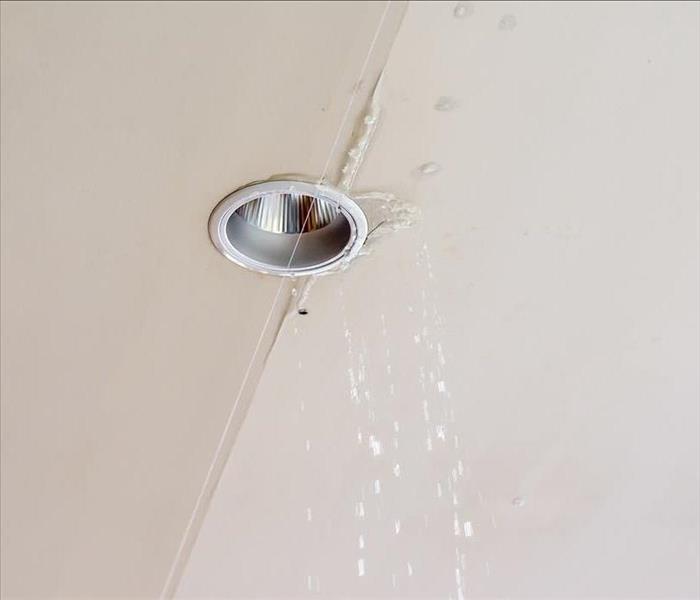 Water in light fixtures can be difficult to deal with but knowing what to do is important.
Water in light fixtures can be difficult to deal with but knowing what to do is important.
Water dripping from a ceiling fixture is one of those things you never expect to happen, but is important to know how to handle if it does. Water should drip from your roof if it rains or snow is melting, but dripping into your home water in light fixtures is not normal and needs to be addressed immediately. Do you know how to handle this kind of emergency? Here are some things that need to be done immediately.
First Steps To Take if Water is Dripping From the Lighting
1- Turn off all electrical breakers to the area
2- Try to locate source of water in light fixtures. If from pipes, shut off water
3- Call an electrician and a plumber East Dundee, IL, right away for help to stop the leak and check the extent of the electrical damage
The first order of business should be to shut off the electricity. Water and electricity are a dangerous combination. You need to buy some time to discover and remedy the source of the leaking and shutting off the electricity may help buy that time. If the source is a leak in your roof, you will need to have someone repair it as soon as possible to prevent further damage. If the source is a bathtub overflowing or a broken pipe in the ceiling, you may possibly incur ceiling damage if it is not stopped immediately.
If the ceiling is bulging, that could mean there is a good deal of water building up and the weight is becoming too much for the structure to bear. It might be wise to move your belongings out of the area until things are resolved. You may want to call a professional restoration company in East Dundee, IL, to assess ceiling damage and help with any restoration that is needed.
Water in light fixtures can be difficult to deal with but knowing what to do is important. Taking a few specific steps can have things back to normal quickly, giving you peace of mind.
Steps for Replacing a Leaky Toilet
12/19/2021 (Permalink)
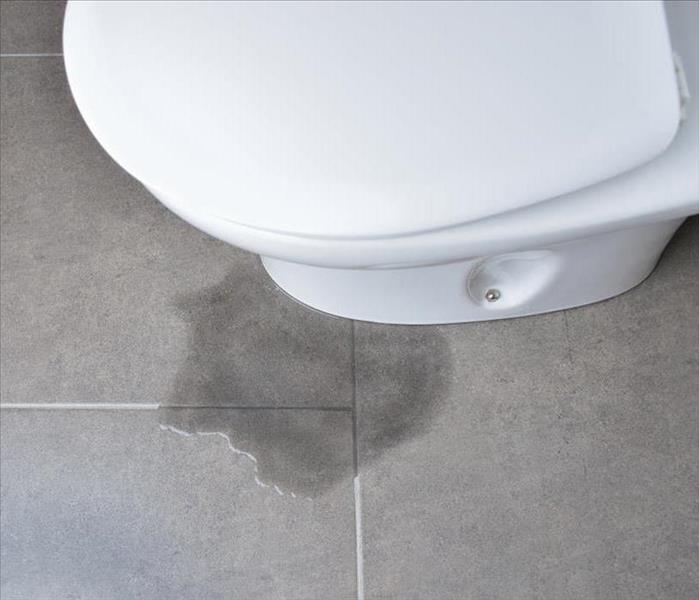 A leaking toilet in a home in Sleepy Hollow, IL.
A leaking toilet in a home in Sleepy Hollow, IL.
How to Replace a Leaky Toilet
The toilet may be one of the more reliable plumbing fixtures in your Sleepy Hollow, IL, home. But on occasion, one can develop a leak leading to water damage. If you have a leaking toilet at your residence, here are a few things you can do.
1. Check the Fittings
The first step in toilet repair is to check the water lines for leaks and tighten any loose fittings. If any of these things are loose or cracked they may be the source of your leak. If the fittings and water line are in working order, then the cause of the leak may be the wax seal located under the unit’s base.
2. Check the Seal
In many cases, a failed wax seal under the leaking toilet is the source of the problem. If there are no issues with the connections, and the water is pooled around the toilet’s base, this may be the issue. You will need to turn off the water and drain the toilet before you can remove it to check and replace the wax seal.
3. Replace the Toilet
If repairing the fittings or seal on the old toilet don’t work, it may be time to replace the unit. Before installing the new unit check the area for any water damage the leak may have cause. A water damage restoration service can help with any cleanup and repairs that may be needed. Once you're sure the area is clear of damage, you can put the new unit in. Be sure to follow any instructions and to properly connect all fittings and hoses.
If you have a leaking toilet you can try to repair it, or replace the unit. Be sure to follow the instructions for your toilet unit to insure a proper connection with the hoses and fittings. A professional may be able to help. If the is water damage in your home from the leak a water damage restoration technician can provide cleanup and repair services.
Water Damage: Three Important Facts
11/26/2021 (Permalink)
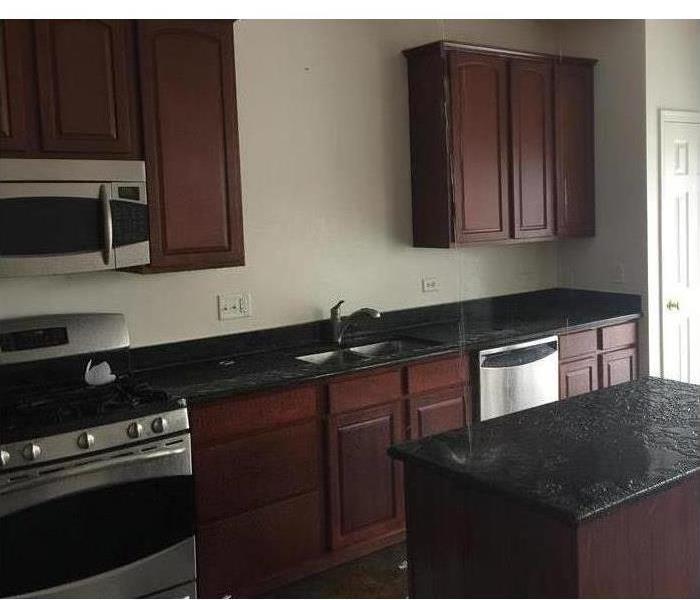 SERVPRO arrived at this home with water damage to the kitchen.
SERVPRO arrived at this home with water damage to the kitchen.
Water Damage: Three Important Facts
You may be worried about water damage if you recently experienced a pipe burst in your Gilberts, IL, home. Such situations can cause flooding and other issues but try not to panic. Instead, learn about the following three facts, so you can be prepared for any future problems that arise.
1. Damage
When water enters your home, it can damage many different structures. However, the severity of the damage can vary widely. There are three recognized classes of water damage:
- White or Category 1 Water Damage: This is clean water.
- Gray or Category 2 Water Damage: This is often waste water.
- Black or Category 3 Water Damage: This is considered contaminated water.
Category 3 damage is urgent and requires quick cleanup, while Category 1 water is not contaminated, but still requires rapid cleanup. A broken water line that leads to a pipe burst typically will only result in Category 1 damage as long as the matter is quickly addressed.
2. Restoration
Taking advantage of remediation services is not always just a practical move. In cases where you are dealing with complicated damage, such as when white water is left to sit for too long, a service may be necessary. Most trained workers will arrive on the scene quickly, assess the damage and take measures to restore your property.
3. Salvage
You may think that the random valuables around your home cannot be saved after a water damage incident. This is not always the case. Technicians such as those mentioned above can typically help you remove certain furniture and personal items and may even offer move-out assistance to help you preserve items before they get damaged. Most professionals also understand that your keepsakes are precious and may attempt to restore photographs and other mementos.
A pipe burst at home is never fun, but understanding the issue at hand helps. If you put an action plan into place, you have a better chance of returning to normal life sooner rather than later.
What Is Category 2 Water Damage?
9/27/2021 (Permalink)
 Commercial property owners dealing with a Category Two leak should take steps to fix the cause and prevent the situation from becoming more serious.
Commercial property owners dealing with a Category Two leak should take steps to fix the cause and prevent the situation from becoming more serious.
Category Two water damage involves gray water that may contain bacteria or chemicals but does not contain solid waste. Leaks involving Category Two water may be caused by sewer backups or result from leaks of clean Category One water that call for water pipe repair becoming contaminated. Learn more about what differentiates Category Two water from clean water and Category Three black water.
Where Does Category 2 Water Originate?
Category Two water often originates as Category One water. For instance, if clean water from a broken pipe sits too long or filters down from one flooded floor through building materials to a lower floor, this water has become Category Two. Shower and toilet water that does not contain solid waste is also considered Category Two.
What Is The Category 2 Cleanup Procedure?
As Category Two water may contain bacteria, it is necessary to disinfect the area affected by a leak. Cleanup should commence with the removal of all water followed by cleaning, disinfection, and thorough drying to reduce risks of infection or mold. Be sure to address the cause of the problem, whether this involves clearing a sewer blockage or water pipe repair.
Do Category 2 Leaks Pose Any Risks?
Category Two water may contain bacteria and pose a risk to persons with compromised immune systems. The major risk with any water leak that originates from a broken pipe or any other source is mold. Thoroughly dry the exposed area, including all porous or semi-porous materials and contents, to prevent mold from starting to grow.
Commercial property owners dealing with a Category Two leak should take steps to fix the cause and prevent the situation from becoming more serious. Schedule a water pipe repair or clear any clogs causing backups and clean and dry the flooded area. Contact a water damage restoration service in Gilberts, IL, to restore any damage.
Tips for Dealing With a Leaking Water Heater Until Help Arrives
6/24/2021 (Permalink)
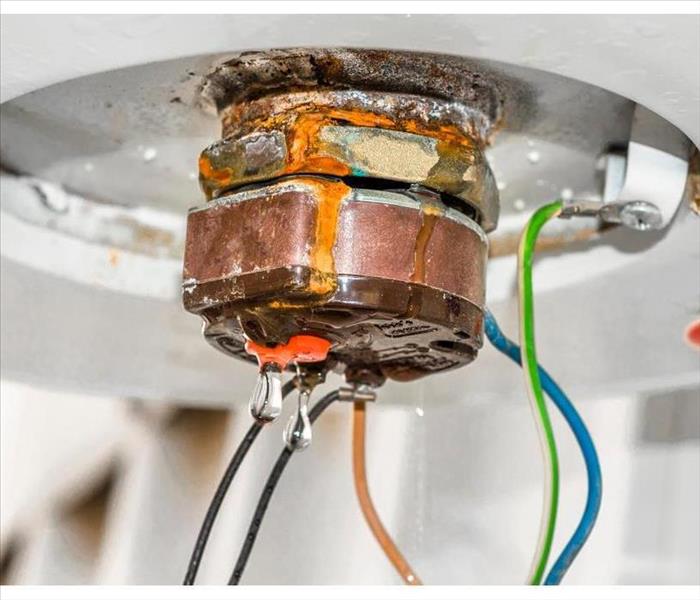 Leaking water heater
Leaking water heater
Dealing With A Leaking Water Heater
A broken water heater is a bad enough experience, leaving you with a cold shower and an inconvenient surprise for your day, but when you also have a leaking water heater, the experience is much worse. First, learn to recognize signs of trouble.
- Loud rattling noise coming from the water heater
- Lack of hot water
- Visible signs of water around the heater tank, such as pooling or leaks
- Water dripping from pipes or tank
As soon as you recognize any of these signs of a failed water heater, contact a Sleepy Hollow, IL, professional.
Shut Off the Water Supply
While your water for help to arrive, there are some steps you can take to minimize damages. First, locate the main water shut-off valve and look for the water heater shut-off valve near it. If you can't quickly locate the valve to the water heater, use the main valve to shut off the water to your entire home.
Turn Off the Water Heater
The next step is to turn off the water heater. Most of these appliances have shut-off instructions located on the tank or exterior of the heater. Usually, you'll find a black knob somewhere near the base of the heater.
Clear the Space Around the Water Heater
Finally, prepare for the professional to arrive. Whether your leaking water heater is powered by gas or electricity, the system is complicated and delicate. You'll put yourself, your family, and your home in danger if you try to handle the high levels of pressure and hot water. Instead, clear the space around the water heater, if it is cluttered and make sure the professional will have room to work.
Address Water Damages
If carpeting or furnishings have been affected by leaking water, turn your attention to preventing water damage. When professionals arrive, they may have further advice on how to prevent secondary damages due to the leaking water heater.
3 Steps for Using a Drain Snake
3/15/2021 (Permalink)
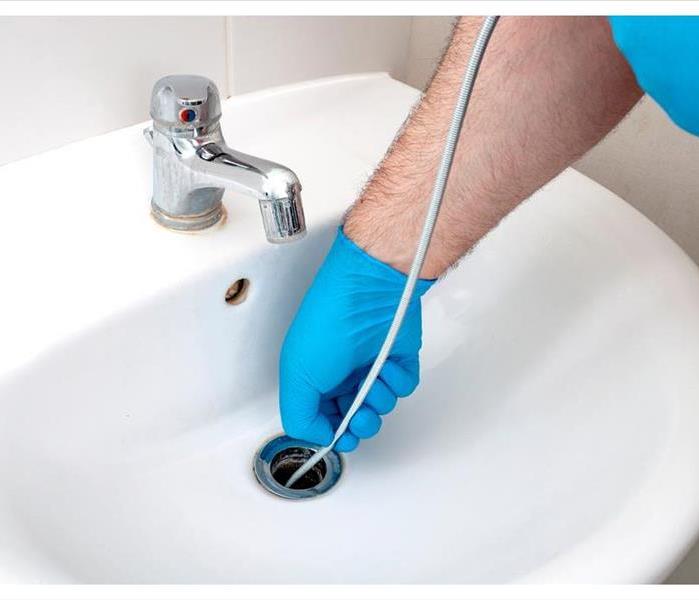 A stopped drain is a pain.
A stopped drain is a pain.
Tips To Properly Use A Snake
If it looks like a snake, moves like a snake, and is made out of metal, you're probably not sure what it is or what to do with it. This tool is called an auger. Most people call it a drain snake and use it to remove debris from clogged pipes. The next time your plunger just isn't doing the job, follow these tips to properly use a snake without creating a disaster that requires a water remediation company.
1. Acquire the Snake
The first thing you need to do to clear your clogged drain is to acquire a snake. There are both old school and electric models available. You can find them at any hardware store in Sleepy Hollow, IL. While a good one may cost a few dollars, think of all the money you're going to save by not having to call a plumber every time your pipes won't drain. If you still don't want to buy one, larger home-improvement stores often offer them as rentals.
2. Prepare the Area
Start by putting on some gloves and having a bucket nearby. These will be handy for when you pull a glob of something out of your drain. You may also want a towel to set the auger on after the process. Once you have prepared the area, get the snake and get ready to work.
3. Insert the Snake
Start by inserting the snake into your clogged drain and giving it a few hard cranks to get the tip around the trap. Keep pushing until you reach the blockage. At this point, you will rotate the head. Often, you will know it is time to rotate the head because you will feel resistance, or your auger will not want to turn. Although it is tempting to get rough, you must continue to be gentle as you pull the clog out to avoid a pipe break or other situation.
A stopped drain is a pain. Fortunately, you can follow these steps to get it clear in no time.
3 Things To Do When Turning On Your Irrigation Sprinklers
2/17/2021 (Permalink)
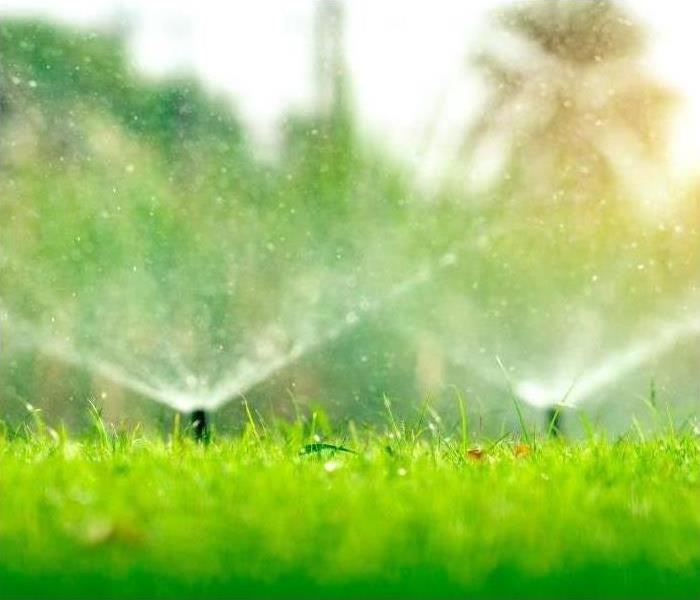 When the temperature starts to rise, you need to perform some irrigation maintenance.
When the temperature starts to rise, you need to perform some irrigation maintenance.
Here Are Three Helpful Steps
As a business owner, you probably turned your irrigation sprinklers off before winter. Winterizing the system is especially important for areas with a long season where the plants are dormant. When spring returns, it is time to turn this system back on. However, when the temperature starts to rise, you need to perform some irrigation maintenance. Doing this ensures you have a welcoming lawn this summer. There are a few key steps to take to maintain your sprinklers as you turn them back on properly.
1. Turn the Water on Slowly
The most important part of irrigation maintenance is to turn the water on slowly. If you turn it on too quickly, you will blast your sprinklers with a high amount of pressure. This can lead to the heads popping off, fittings breaking, and sprinkler flooding on your lawn. You can ensure that the pressure stays low and you don't have any problems by slowly turning the water on.
2. Locate the Shut-Off Valves
There are a few valves you will need to find before you can turn your sprinklers on. Make sure you know where the stop, waste, and pressure vacuum breaker valves are located.
3. Turn On the Valves
To move the waste and stop valves for your system in West Dundee, IL, you will need a key. Take the key and turn them 90 degrees counterclockwise. They may leak at first, but this should stop momentarily. Additionally, you will find the pressure vacuum breaker next to the valves. When it is parallel to your line, it is on, and if it is perpendicular, it is off. You want to make sure this is on before unleashing the water. Remember to turn all of your valves slowly.
You should follow proper irrigation maintenance protocols when turning your sprinklers back on in the spring. This ensures you don't do any damage and need to hire a water remediation company.
Preparing for Your Insurance Adjuster's Visit
1/11/2021 (Permalink)
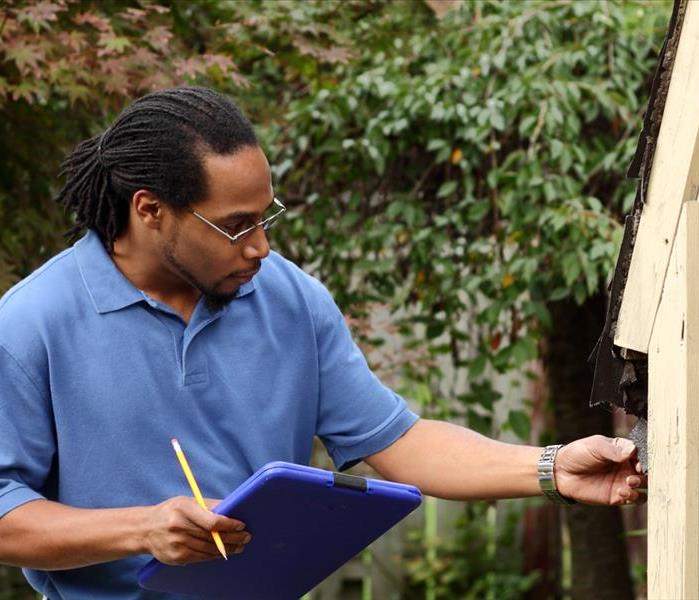 A home adjuster needs to examine the damage
A home adjuster needs to examine the damage
Preparing for Your Insurance Adjuster's Visit
When an unimaginable event happens and your home in Sleepy Hollow, IL, has suffered extensive damage, it can be difficult to know where to turn. It's important to call a storm damage restoration service to help with the repairs. Once you've determined that you can stay in your home, you must also call your insurance agent as soon as possible. A home adjuster needs to examine the damage if you plan to file a claim. Before you make the call, prepare as much information as you can to speed up the process.
1. What To Ask Your Insurance Agent
It's important to determine if the damage is covered under your policy. For example, flood damage is not part of the typical home owner's policy. Separate insurance must be purchased through the National Flood Insurance Program. Make sure you ask your agent the following questions:
- How long do you have to file an insurance claim after the event?
- How much is your deductible?
- Do you need to call repair services before a home adjuster can visit?
- How long will it take to receive payment?
2. How To Prepare for the Adjuster
Before you schedule a visit, collect as much information as you can to speed up the process:
- Gather receipts of all the supplies you purchased to make basic repairs.
- Inspect the house thoroughly so that you can quickly point out structural damage or damaged roofing.
- Take pictures of all damaged items and create an inventory of each item, along with its estimated worth. Make sure to keep all the items for the adjuster to personally inspect.
- Make sure any contractors' bids detail the repairs needed.
- Keep copies of everything you plan to give the adjuster. It's a great idea to put all papers and photos in a binder to keep everything together.
An experienced home adjuster will help you get back on your feet as soon as possible.
How To Unfreeze and Prevent Frozen Pipes
11/30/2020 (Permalink)
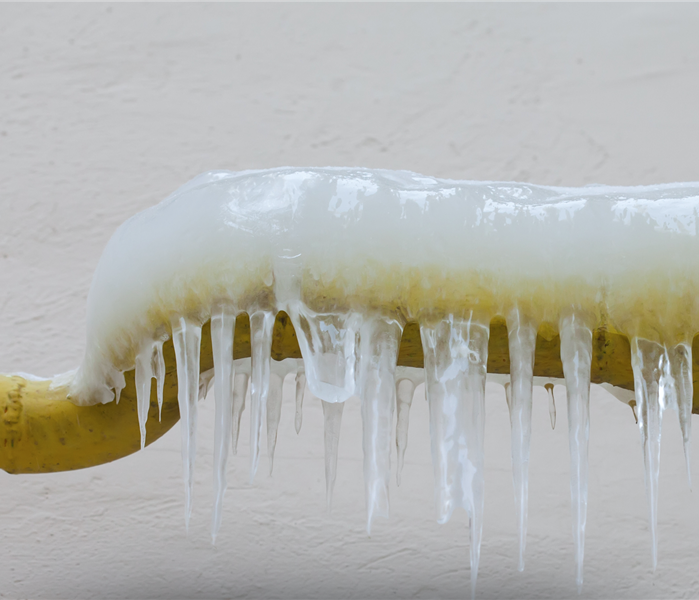 Determine which pipe is frozen
Determine which pipe is frozen
Unfreezing Pipes
Frozen pipes are quite common during the cold winter months. A pipe freeze can cause your water to stop running. Even worse, the pipe could burst and spray frozen water all over your Carpentersville, IL, home. If you suspect that one or more of your pipes has frozen, follow the below steps.
1. Find the Pipes
First, you have to determine which pipe is frozen. Turn on all of your faucets to see which ones have water flowing through them. You can use this information to narrow your search. Utilize a thermometer to measure the temperatures of the pipes. Leaks or cracks could be evidence of a frozen pipe, as well.
2. Heat the Pipe
Use a heat gun or hair dryer to warm the frozen pipe. Do not put the heat source directly on the pipe, as this could cause the pipe to rupture.
3. Add Salt
Just as you use salt to melt your driveway, you can also utilize it in your frozen pipes. Pour a tablespoon of sodium chloride down the drain to start the thawing process.
Preventing Pipe Freeze
Once you have thawed the pipes, you should prevent them from freezing in the future. The best way to do this is to add insulation. Use rags, heat tape or sponge covers to wrap pipes in cold areas of your house. You should also limit the amount of wind and cold air that enters your home.
If freezing temperatures are heading your way, consider placing an incandescent light bulb near the pipes that are prone to freezing. Make sure there are no flammable materials nearby.
Finally, you can leave the faucets connected to the problematic pipes slightly open overnight. The water will not have time to freeze if it is running through the pipes.
Frozen pipes are not just a minor inconvenience. They can also cause massive flooding. While water damage restoration specialists can help you clean up after a pipe burst, you should try to prevent this emergency entirely.
5 Tips to Help Prevent Water Damage
10/8/2020 (Permalink)
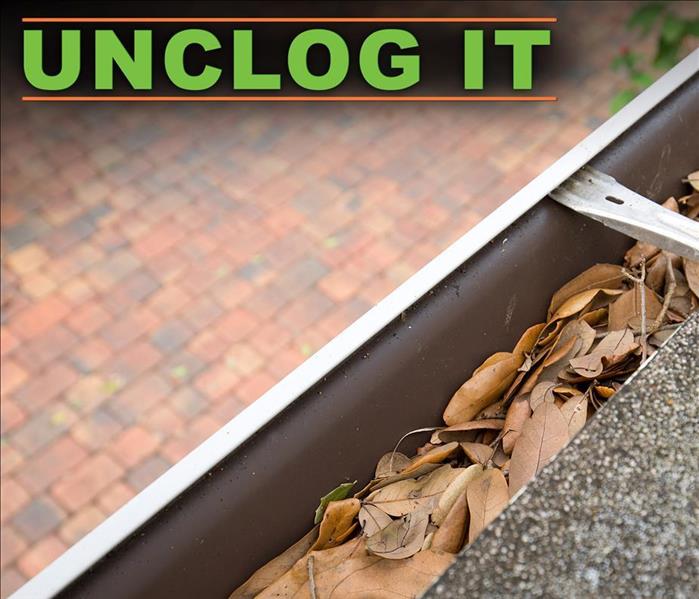 Always clean your gutters!
Always clean your gutters!
Tips On Protecting Your Home From Water Damage
Standing or overflowing water in home can cause plenty of major issues if not properly resolved. Because water damage can cause so many subsequent problems, your best course of action is to prevent the damage from occurring in the first place. Follow the tips below to help protect your home in Barrington Hills, IL, from water damage.
1. Inspect Appliances Regularly.
Minor leaks can often go unnoticed for long periods of time, resulting in massive amounts of water damage. Checking household appliances, such as washing machines and dishwashers, can help prevent unwanted gray water flooding.
2. Maintain Appropriate Water Pressure.
The pipes and hoses in your house can break if the water pressure is too high. Maintaining an appropriate level of water pressure can help prevent you from having to deal with unnecessary pipe cleanup.
3. Check for Leaks and Broken Pipes.
Much like household appliances, leaky pipes can often fly under the radar for long periods of time. Take the time to regularly inspect exposed pipes in the basement and underneath the sinks for leaks. A broken pipe can result in a lot of unnecessary water damage.
4. Clean Standing Water Immediately.
No matter the cause of the water at home, it's vital that you mop it up as soon as you can. Water can seep into carpeting, floorboards, and other materials, causing hazardous secondary damage.
5. Unclog Your Gutters.
Your gutters are designed to catch water that runs off the roof and safely divert it away from your house. Falling debris, such as branches and leaves, can clog these gutters, which hinders their ability to perform their duties. When the gutters are clogged, rainwater and snowmelt can either pool on your roof, or drip down the side of your property and seep into the foundation.
There are several easy methods that can help you prevent water in home from causing unnecessary damage. If you suspect that you might have water damage, you need to contact water remediation experts as soon as you can to help prevent subsequent problems.
5 Common Sewage Issues in Commercial Buildings
9/3/2020 (Permalink)
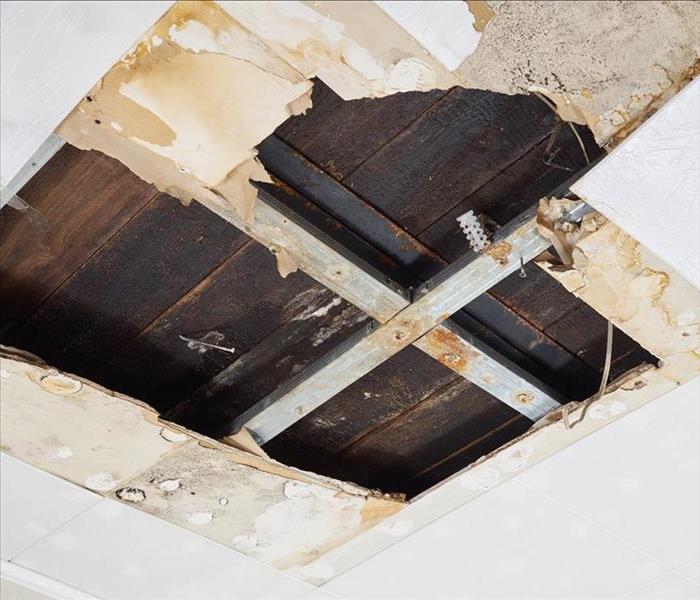 Ceiling damaged by water
Ceiling damaged by water
5 Common Sewage Issues in Commercial Buildings
It's natural for buildings to break down after a while. This fact just makes preventative maintenance that much more important. Learning to spot common sewage issues, such as a blocked sewer or broken pipe, can help prevent you from having to deal with more problematic damages later on. Arm yourself with knowledge so you can protect your building in Carpentersville, IL.
1. Damaged Water Pipes
Pipe breaks are an open invitation for water damage and mold growth. This type of damage can be hard to catch early if you don't have exposed pipes. You should enlist professional help if you notice that your walls or ceilings have water stains.
2. Foundation Damage
A building's foundation is vital to its structure; it keeps the whole thing standing. Once the foundation is damaged, it's only a matter of time before everything else follows suit. Some damage is easier to spot, such as cracks in the ceiling and walls. Other forms might require a trained eye to uncover.
3. Worn Out Cast-Iron Sewer Lines
Nothing lasts forever, and a cast-iron sewer line is no exception. These lines are typically designed to last about 25 years, but neglecting to care for them properly can cause them to break down sooner. If you detect a nasty, sewage smell, then it's time to call the professionals.
4. General Water Leaks
Water leaks can come from anywhere, such as broken pipes, toilet overflow, and a blocked sewer. Much like every other item on this list, the key to protecting your building is early detection. Take time to regularly inspect your piping and drainage systems to prevent incidents.
5. Copper Pipe Damage
Copper pipes can be susceptible to pinhole leaks and other types of damage. Regularly replacing worn-out equipment before it busts open is a good way to prevent water damage.
Plumbing issues are quite common occurrences on commercial property. If left unchecked, a blocked sewer, broken pipe, or other types of leak can cause massive amounts of water damage. It's important to enlist the help of flood remediation specialists if you find yourself dealing with one of these problems.
Why the Shower Pan Can Be a Source of Water Damage
6/1/2020 (Permalink)
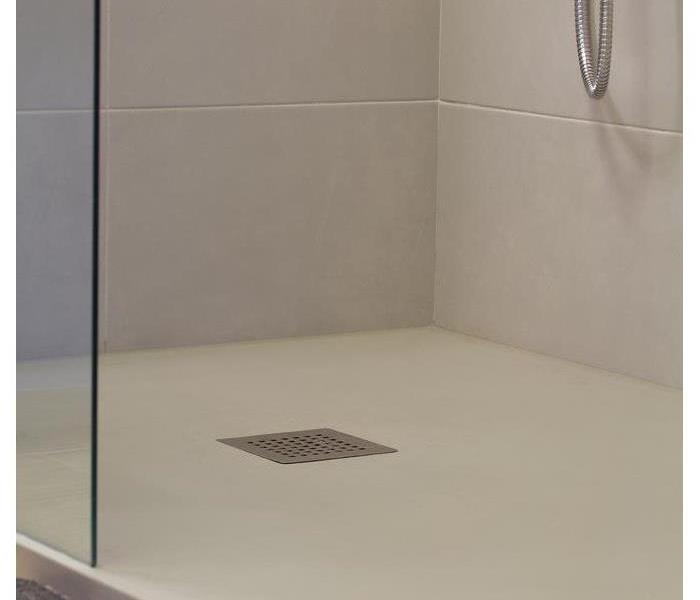 Shower pan leaks are seen as commonly as bathtub leaks
Shower pan leaks are seen as commonly as bathtub leaks
Anywhere a home has plumbing fixtures and pipes, there is a danger of a leak. Pipes get old and break, fittings loosen and connections fail. With all of its water lines, a bathroom will occasionally become a trouble spot and a bathtub leak is something to keep an eye on. This particular problem can be especially harmful because the escaping water is not always visible right away, allowing water time to rot the wood subfloor and to increase the humidity in the bathroom. In these conditions, mold can become a problem since it grows well in damp, warm conditions. The key is to stop the water leak and thoroughly dry out the area. A local water remediation franchise in East Dundee, IL, can treat the problem, remove mold, and restore water damage.
Addressing a Shower Pan Leak
Shower pan leaks are seen as commonly as bathtub leaks. They can be just as difficult to locate — the water leaks from the bottom of the shower and is not always readily apparent. You should look for the following signs of a water leak around your shower:
- The growth of mold in the bathroom
- The presence of water stains around the shower or in the ceiling below
- Missing grout
- Cracks in the shower
- A loose drain
If your shower is old, this area is more likely to spring a leak. In this case, it is a good idea to periodically inspect the area around the shower for moisture.
Addressing Water Damage
In the event of a shower or bathtub leak, you want to limit the level of water damage to your home. The best way to do this is by discovering the leak quickly and taking quick action. A slow, gradual leak has the potential to break down materials that are expensive to fix or replace. Mold growth can also become a concern and could require the services of trained removal technicians. Water leaks should be addressed in a timely manner.
Troubleshooting Your Commercial Irrigation System
5/13/2020 (Permalink)
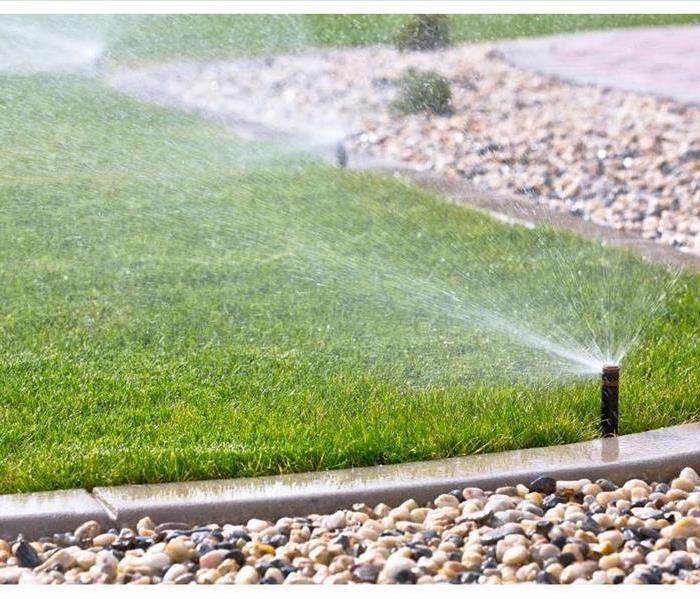 An irrigation system is a great way to easily maintain the exterior of your commercial property
An irrigation system is a great way to easily maintain the exterior of your commercial property
Troubleshooting Your Commercial Irrigation System
An irrigation system is a great way to easily maintain the exterior of your commercial property. However, when sprinklers malfunction, they can cause major issues. Broken sprinklers can lead to a buildup of standing water near your East Dundee, IL, building. The water can then enter the basement or seep through the foundation.
There are various signs that your sprinkler system is failing. They include:
- Gushing water
- Failing timer
- Seeping water
If you notice any of these issues, you first need to find the source and location of the irrigation problems. Ideally, you should try to find and address the malfunction quickly before it becomes a larger failure. Below are some sprinkler troubleshooting tips.
Causes of Sprinkler Issues
Some irrigation system problems are easy to diagnose. For instance, gushing water may simply be the result of a broken sprinkler head.
Malfunctioning timers, meanwhile, are likely the result of an electrical issue. Make sure the wires are connected properly. If the wires are corroded, they may need to be repaired or replaced.
Causes of Pipe Problems
Water seeping out of your sprinklers may be evidence of a cracked pipe or split joint. Pipe issues may result from excess traffic outside your facility. As people walk, bike or push strollers, the soil below them compresses due to the extra weight. This can also cause the supply lines to crack.
Tree roots can cause sprinkler pipes to break, as well. The roots can force themselves into the pipe, causing it to leak. Reduced water pressure from your irrigation system may be evidence of this issue.
A broken sprinkler system could cause your customers or clients to complain. You could also end up wasting water throughout your property.
Ideally, you should troubleshoot your sprinklers before they lead to major damage. However, if you do discover excess water within or outside your building, flood cleanup specialists can restore the premises.
Storm Guide Preparation
1/29/2020 (Permalink)
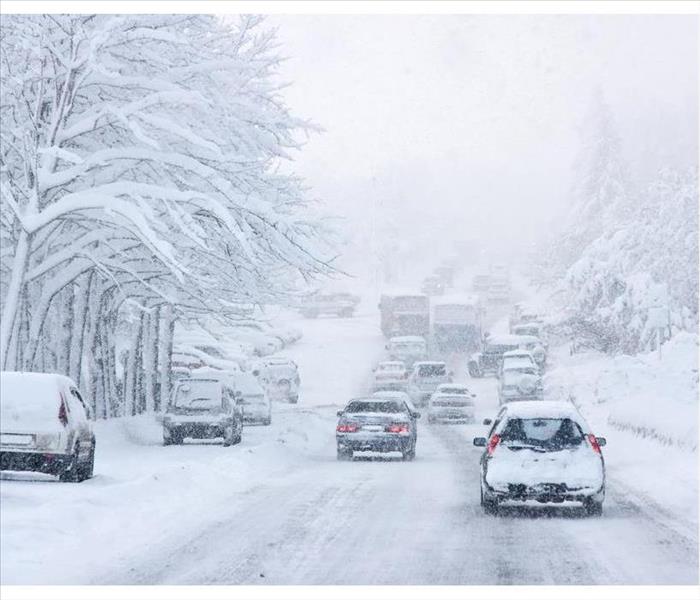 When a winter storm blows in, be proactive
When a winter storm blows in, be proactive
Three Tips for Getting Ready for the Blizzard
Snow falling makes for a beautiful scene; however, a winter storm is another matter. Its ferocity could be problematic for your business. As the snow flakes pile up in West Dundee, IL, be aware of how to safeguard your establishment. Here are three tips for getting ready for the blizzard.
1. Have a Plan
Don't let storm damage catch you off guard. Anticipate problems, and know how to react. Speak with employees and management about how to prepare. Show them where to locate weather updates, and determine how and when decisions need to be made about securing the store. This should include a step-by-step guide to moving items into higher ground, turning off the water system and how to board up exposed areas such as windows and glass doors.
2. Inspect the Grounds
A winter storm's impact may start from an external object. Part of protocol should be walking around outside, looking for any potential complications. When those inches fall, they are going to create weight. Trim tree branches back they don't snap into the walls or roof. In addition, make sure the roof is not vulnerable. Exposed sections or holes mean water penetration. Try and avoid saturation problems and mold by placing tarps over the weak sections of shingles. In addition, examine the gutters and the flashing. You want to avoid a cave in.
3. Record and Respond
Be cautious when you return after a severe weather system. Flooding may have damaged the area. Shut off the power, and begin to survey the destruction. During this time, record and document anything noticed, writing it down and taking photos. If you suspect issues with water, mold or fire, contact a disaster restoration company immediately. The experts can evaluate the property, determining the need for remediation. This includes boarding up open areas, removing contaminated objects and rebuilding impacted rooms.
When a winter storm blows in, be proactive. Pay attention to developments, and set up ground rules that everyone knows and can follow. Then, if something occurs, seek help as soon as possible.
What Are the 3 Types of Contaminated Water?
12/12/2019 (Permalink)
 Water categories
Water categories
Which Type of Water Is Safe Or Unsafe In Your Home
For all its utility, water can be very dangerous under certain circumstances. Those include following a flood when contaminated water can invade homes and set the stage for serious illness. Keep reading for answers to which type of water is safe or unsafe in your East Dundee,IL, home and why.
Flood Side Effects
Anyone who has experienced a home flood knows how devastating they can be. Besides making portions of your home immediately uninhabitable, floods can create a seemingly endless number of after-effects such as:
- Mold and mildew
- Property damage
- Bacterial contamination
The last item is one that doesn’t occur to most homeowners. However, floodwater can be a major source of disease depending on where it came from and its method of contamination. There are generally three levels of contamination.
Clean Water
This is the best type of water to face. Also called category 1 water, it comes from faucets, toilet tanks, appliance supply lines and even melting snow. It hasn’t contacted human or animal waste. Its biggest threat is causing mold growth in your home.
Gray Water
Also called category 2 water, gray water is the intermediate dirty water type. This water is best described as mildly contaminated. Sourced from washing machines, sinks and the like, it hasn’t met with fecal matter but it can still cause mild illness. If given enough time, this water can progress to the worst flood water type.
Black Water
Also referred to as category 3, this contaminated water type is unequivocally unsafe. Sourced from outdoor flood waters or even sewage, this water is usually rich with chemicals and disease-causing organisms and must be professionally removed fast.
Contaminated water is often an unexpected but serious side effect of home flooding. If you’re facing a home flood and aren’t sure if you can safely remove water, contact a water cleanup specialist for advice on how to proceed.
Nothing Contaminates a Home Like an Overflowing Toilet
10/15/2019 (Permalink)
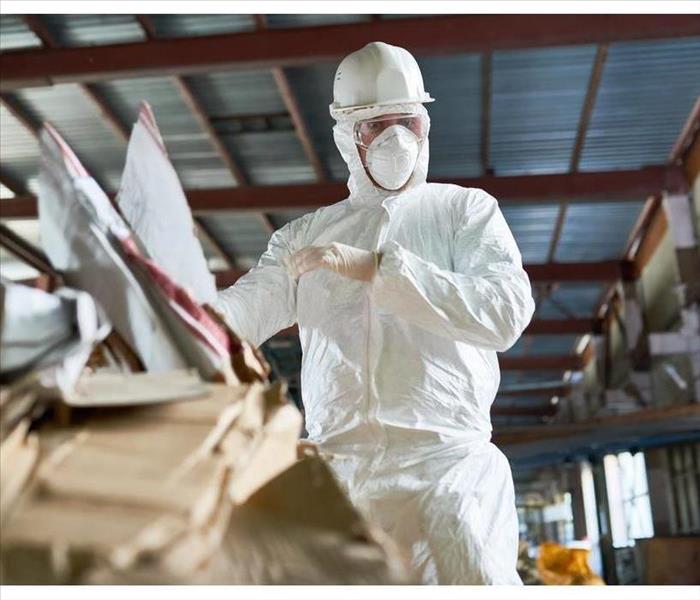 Dealing with raw sewage requires protection
Dealing with raw sewage requires protection
The toilet plays an essential role in your Barrington Hills,IL, home. It is a simple and effective entry point to your local sewage treatment facility. If the sewage company keeps the sewers maintained, your home remains safe and clean. Unfortunately, sewer damage can change all that.
Sewage Doesn’t Only Flow Outward
A damaged sewer can cause the city’s waste to back up, overflow a toilet and contaminate your home. When city sewage comes to visit, that contaminated waste becomes a serious threat to your family’s health and home. Specially trained sewage remediation specialists have the knowledge, experience and equipment to make your home clean and safe again.
Dealing with raw sewage requires protection. If you decide to involve yourself in the cleanup, you should have the following protective equipment at your disposal:
- Tall waterproof boots
- Arm-length rubber gloves
- Protective mask
- Safety goggles
Even a Simple Flooded Toilet Can Be Unhealthy
Sewer damage is not the only cause of flooded toilets. Each toilet seems to have a personality. Some you can flush and walk away. Others require you to wait to make sure there isn’t a problem refilling. There are also toilets that will continue to run if you don’t wait and jiggle the handle. Some family members, especially young children, don’t understand that a toilet is not a wastebasket. Others need reminding that repeat flushing is almost never a solution to a blocked toilet.
In most of these cases, a simple overflow may appear to be clean water. However, the water still contains contaminants. Your bathroom area will not be completely safe until it is dry, clean and disinfected. It is also important to understand that water flows into cracks, behind walls and into the subflooring. The spreading moisture will make the cleanup more difficult and encourage mold growth.
There Is Life After Sewage
Sewer damage is never pretty. Cleanup may seem impossible. However, with a great team on the job, your home will soon look “Like it never even happened.”
What Homeowners Should Know About Flushing Their Home's Water Heaters
8/30/2019 (Permalink)
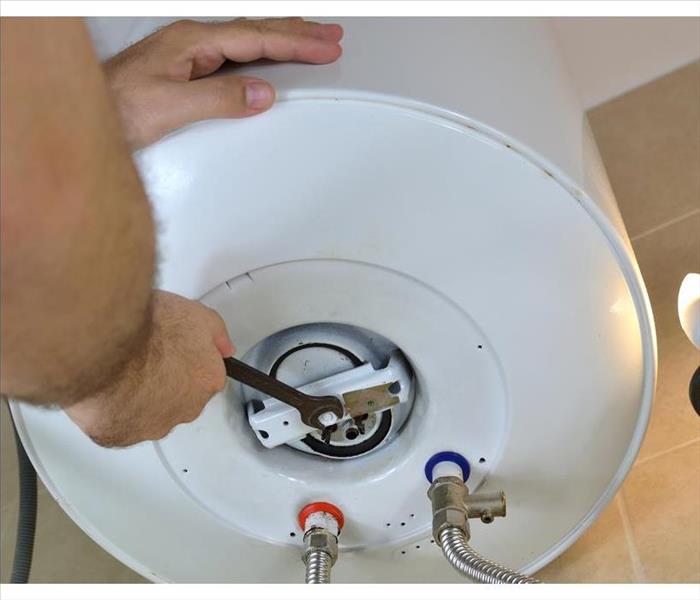 Flushing a water heater in East Dundee, IL
Flushing a water heater in East Dundee, IL
The water heater in your home in East Dundee,IL, is an important piece of equipment that allows you to take a hot shower or bath, clean your clothes and wash your dishes. However, many homeowners don't know how to maintain their water tanks. As a homeowner, it can be useful for you to learn more about flushing your home's hot water tank.
Why Should You Flush Your Heater?
Many homeowners aren't sure why they should flush the hot water tanks in their homes. However, there are several reasons it is beneficial to perform a hot water heater flush every year, including to:
- Prevent the build-up of sediment in your heater
- Reduce the amount of noise your heater makes
- Decrease the amount of energy your heater requires to function
What Happens if You Don't Flush Your Heater?
If you don't flush your water heater at least once a year, your heater may become damaged over time. A continuous low noise or a loud cracking sound could indicate that sediment has built up in your heater's tank. As a result of built-up sediment, your hot water tank could leak, or you may notice weak or inconsistent water pressure when you use hot water. If you do notice any of these problems, it can be wise to contact experts in water damage restoration.
What Steps Do You Take To Flush the Heater?
There are several steps you can follow to flush your heater effectively. These steps include:
- Turning off the heater
- Placing a hose on the drainage valve and moving the end of the hose elsewhere
- Allowing the water to drain, then turning off the water supply
- Turning off the drainage valve and removing the hose
- Turning on the supply of water to allow the tank to fill up again
- Turning the heater back on
It can be helpful to know how to keep your home's water heater running effectively. Understanding why you should flush your heater, what happens if your heater isn't flushed and how exactly to flush your heater can help you to maintain the hot water tank in your home.
Tips for Replacing Your Bathroom Supply Line
6/13/2019 (Permalink)
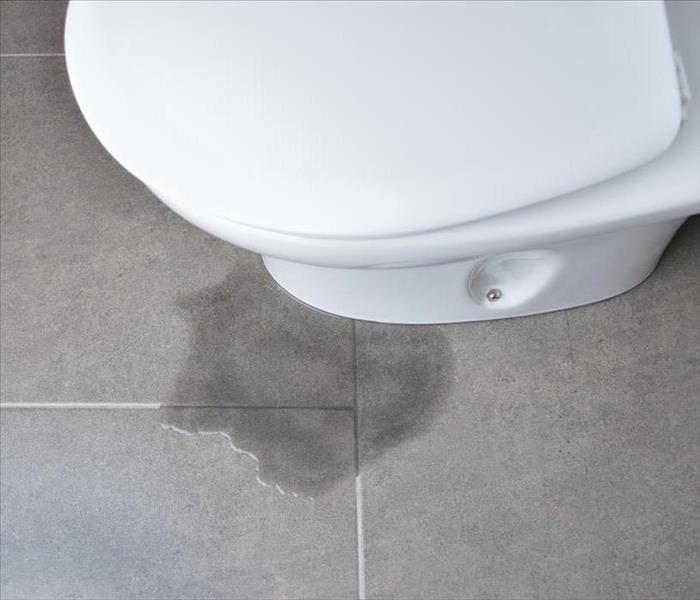 Water accumulating beneath a toilet
Water accumulating beneath a toilet
A bathroom water supply line is a resource you take advantage of everyday in Barrington Hills,IL. Although it is out of sight, it should not be out of mind. If you notice a bathroom leak, this may be the culprit. Regardless, you should be changing your supply line about once every ten years.
Is It Time?
The rule of thumb is to replace your supply line once a decade, but it’s easy to lose track. You may have also moved into an older home and be unaware of how long it’s been since the last replacement. In these types of cases, a good place to start is determining if you have supply line damage. The following may give you a clue:
- A damp spot in the ceiling below your bathroom
- Water accumulating beneath your sink or toilet
- Loss of pressure in faucet
Are You Under Warranty?
If you determine you have supply line damage or that it’s time to replace it, the first step is to find out if it is still under warranty. This could save you a lot of time and money. Different types of supply lines hold different warranties- plastic lines have 5-8 years while steel braided lines have a lifetime warranty.
Who Do You Call?
This type of issue is a big job, so to be safe you should probably call a professional supply line leak service to inspect and replace the pipe; you wouldn’t want to cause more damage to your bathroom. Specialists will know exactly where all the connections are, what parts to use and how tight the connections should be. If done properly your new supply line will last into the next decade.
Supply line damage can be dangerous if left alone for too long, so be the best homeowner you can be by staying on top of it. Avoid mold and structural damage by replacing it when appropriate.
3 Water Problems You Might Find In Your Commercial Building
4/17/2019 (Permalink)
 Give SERVPRO a call at the first signs of water leaks.
Give SERVPRO a call at the first signs of water leaks.
Water Problems In Your Commercial Building
If you own a commercial building in Sleepy Hollow, IL, it is likely that you have experienced at least a few water problems. Sometimes these are easy to fix, but some problems, like leaking pipes, can cause lasting damage. If you have any of the following issues, it is best to have them repaired as soon as possible.
1. Leaking Water
This problem is not exclusive to leaking pipes. Any equipment in your building that uses water, such as sinks, toilets, drinking fountains and washing machines, can contribute to this issue. Over time, if the leak is not repaired, it can cause damage to the building and cost you money by adding to your water bill.
2. Clogged Drains
If you are having trouble with sink or toilet backup, then you may have clogging in your drains. Certain items, when they are flushed down the toilet or rinsed down the sink, can contribute to a blockage in the pipes leading away from your building. When this happens, the water will not drain as quickly as it should which can cause backups in the plumbing. In order to prevent this, you should be clear about what items can be disposed of in this way.
3. Broken Pipes
Along with leaks, a pipe break is a common source of water damage. In some cases, such as frozen pipes, this can be caused by severe weather. Other times, it is simply the result of normal wear and tear. Be sure to do regular maintenance on building materials and equipment to reduce the likelihood of broken items.
While leaking pipes and other problems can cause quite a bit of damage to your property, a water damage restoration company can help get everything back in working order. It is best to catch these issues early to keep them from worsening, but even large amounts of damage can be repaired by experienced professionals.
Checklist for Prepping Your Home for Vacation
3/15/2019 (Permalink)
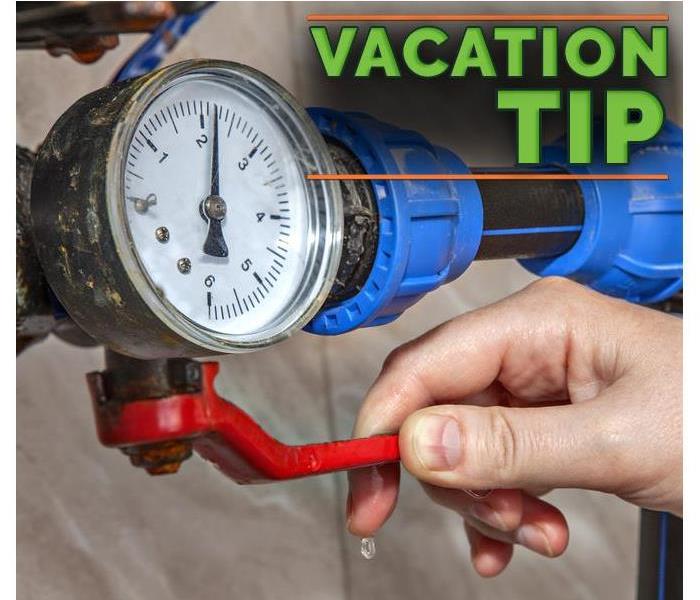 Shut off your water from the main shut off valve to prevent your home from being flooded
Shut off your water from the main shut off valve to prevent your home from being flooded
You and your family may want a getaway, but you don't want to come home to a watery mess that leaves you scrambling for water pipe repair and flood remediation services. To make sure your home in Carpentersville, IL, is safe from water damage during your vacation, check the following items off your to-do list before you leave.
Inspect
A broken pipe often starts with a small leak. By conducting regular inspections, particularly right before you are going to be away for a while, you can find small issues before they become large ones. There are several areas you need to look over before you leave:
- Window seals
- Roof joints and shingles
- Rain gutters
- Appliance hoses
- Sump pump
Look for weak spots and have them repaired. By ensuring that all these things are in good working order, you can prevent damage while you're gone.
Protect
Water pipe repair and cracked hose replacement are not the only ways you can protect your home during vacation. In addition to making sure everything works, add backups and protection to make sure they continue to do so, even if conditions change. For example, installing a backup battery on your sump pump keeps it working even if the power goes out. Adding insulation to both indoor and outdoor pipes and fixtures provides an extra layer of protection against freezing.
Enlist
If you want extra assurance that your home will be safe while you are enjoying your trip, seek out the assistance of a trusted neighbor or friend. Friends can make sure the heat stays on in the winter, pick up your mail and check for sudden problems that may cause damage. In addition to providing a key the person watching your home, it is also a good idea to show him or her how to turn off the water main to prevent your home from being flooded.
Protecting your home is part of planning for your trip. Make your vacation more relaxing by taking the steps needed to know your home is safe.
No, Your Water Heater’s Noises Are Not Normal
1/18/2019 (Permalink)
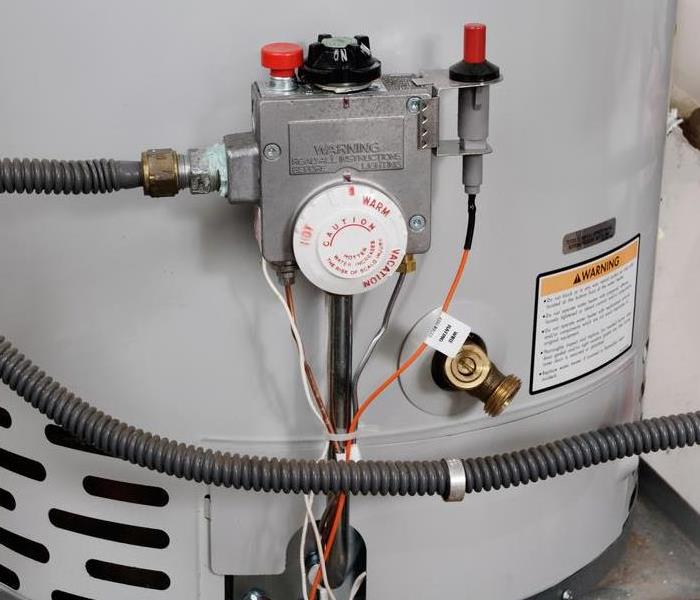 Keep you water heater in your Carpentersville,IL , home in shape.
Keep you water heater in your Carpentersville,IL , home in shape.
Polar bears and penguins probably don’t mind taking cold showers. Because you are neither a polar bear nor a penguin, you must keep the water heater in your Carpentersville,IL , home in tip-top shape. Fortunately, before your home’s water heating system quits altogether, it will likely give you some warning signs.
Signs Your Water Heating System Needs Help
Water heaters usually express signs of distress before they fail completely. If you notice any of the following, your water heating system may be in trouble:
- Leaks
- Corrosion
- Holes
- Noises
- Malfunctions
The Cause of System Sounds
Most water heaters operate without making much noise. If you hear grinding, clunking or other sounds coming from your water heating system, you may need to service it. Often, when sediment accumulates at the bottom of a heater, the unit will emit unpleasant sounds. Scheduling a water heater flush is usually an effective way to remove sediment and restore your unit’s quiet operation.
A Preparedness Plan
If you do not regularly maintain the unit in your home, you may be asking for a flood. After all, leaky water heaters can pump a tremendous amount of water into the living area of your house. While replacing an old, damaged or ineffective system is likely your best strategy for keeping your home in excellent shape, you should have a preparedness plan to address flooding. By working with a water damage repair service, you remove standing water from your home. You also curb mold and mildew growth.
When you step into your shower, you expect a warm and pleasant experience. Naturally, if you prefer not to freeze, you need a water heater that functions optimally. While age, sediment and damage can cause your home’s water heating system to malfunction, you can extend the life of your unit with a bit of maintenance.
Homeowner Basics: Fixing a Faucet
12/19/2018 (Permalink)
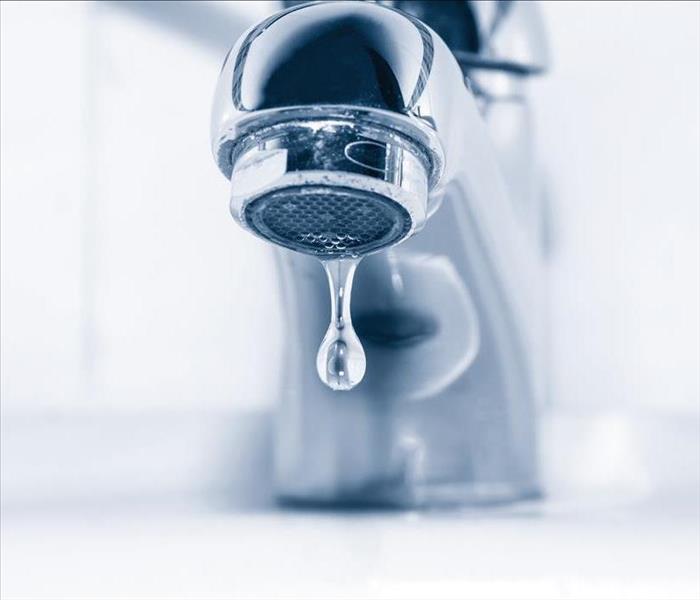 Small leaks can cause big problems in your Carpentersville,IL home
Small leaks can cause big problems in your Carpentersville,IL home
Get some real-life homeowner XP (experience points) by learning how to fix a dripping faucet! These slow leaks are usually due to worn seals or cartridge failure within the faucet assembly. Maintaining the faucets in your home in Carpentersville,IL, is a simple and inexpensive job. Although there are four types of faucets (compression, ball, cartridge, and disc), the steps for repairs are the same.
Basic Steps for Faucet Repair
- Turn off the water supply before you get started repairing the leaking faucet.
- Turn the faucet handle to open the valve so that all remaining water drains.
- Place something in your sink to catch parts that may fall.
- Remove the assembly.
- Replace worn parts with new ones.
- Reassemble and tighten the fittings.
- Turn on water supply and test for the success of the fixed leak.
Sometimes it’s a little tricky to find the screw that enables you to remove the assembly. Decorative caps or hot and cold indicators may be masking the access point. These can be popped off with a fingernail or a screwdriver.
In most cases, the resolution of a leaking faucet just requires the simple tightening of a nut, replacing an expensive piece (such as a cartridge or a seal) or a full assembly (for a ball faucet). Taking apart a faucet is simple and inexpensive in all cases.
Small Leaks Cause Big Problems
You can’t afford is the secondary damages that come from leaking water. When materials are damp, they become a prime location for mold to develop. Mold grows quickly and can become difficult to remove from porous household materials. If you have discovered a leak much too late, you can count on a professional mold remediator to help solve your problem.
You may be tempted to ignore a leaking faucet, but these can lead to damage that will cost you dearly in time and money. These repairs are inexpensive and something any homeowner can do.
Identifying Category 3 Water Damage
10/12/2018 (Permalink)
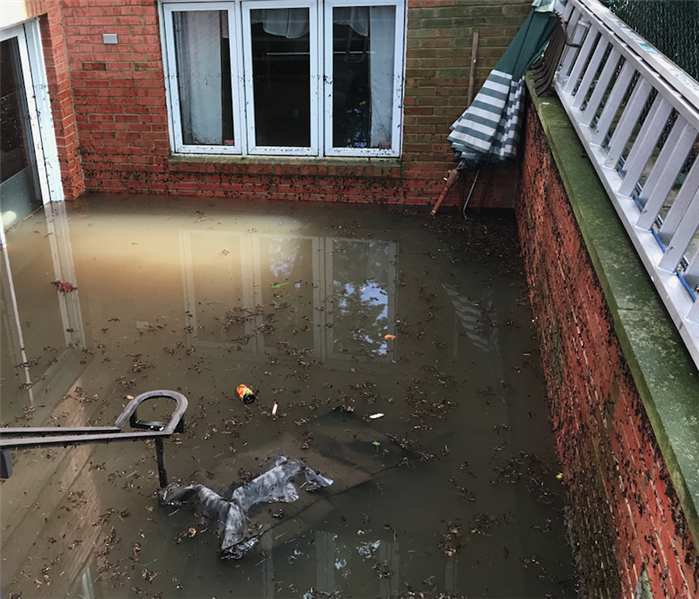 Standing water in Carpentersville,IL
Standing water in Carpentersville,IL
If you are like most homeowners, you probably use the water in your Carpentersville,IL, home every day. When water stays where it is supposed to stay, it allows you to get the most out of your residence. If it ends up somewhere else, though, water can destroy the value, comfort and appearance of your house. Water damage comes in three separate categories. The most severe, category 3, identifies black water.
When Is Water Black?
When talking about water damage, restoration specialists often call serious contamination “black water.” While water may not actually be black in color, this type of water damage is usually both unsanitary and unhealthy. As such, industry experts generally classify the damage it causes as category 3 damage. The following are examples:
- Sewage
- Long-standing water
- Seawater or river water
- Ground surface water
All these sources have bacteria, fungi and other contaminants that can destroy the livability of a home. As such, remediating damage effectively requires knowledge, skill and tools.
How Do Remediation Experts Fix Extreme Water Damage?
Restoration specialists use a variety of techniques to repair water damage. Before beginning the process, they categorize the type of damage. With third-level contamination, specialists often use extreme measures to remove water, clean belongings and dispose of waste. When sewage is involved, experts ensure the home is safe to occupy. Unless you have extensive experience cleaning up after a serious flood, you likely cannot handle this type of remediation without professional assistance.
When Should You Consider Calling an Expert?
Small floods are usually no big deal. When flooding contains contaminated water, however, the livability of your home may be in jeopardy. Remember, you simply can’t ignore black water. For sewage cleanup, you must rely on the expertise and equipment of a professional restoration service in Carpentersville,IL. With the right team, you can likely restore the value, comfort and appearance of your home.
Tips for Dealing With a Leaking Water Heater Until Help Arrives
8/15/2018 (Permalink)
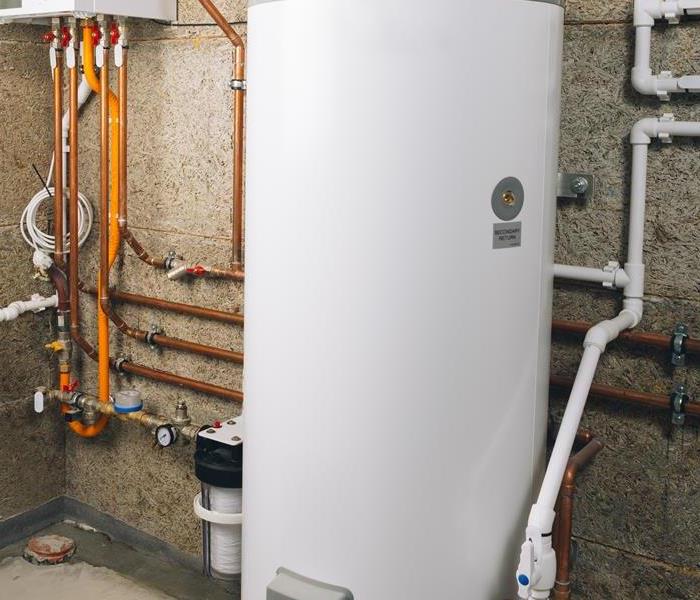 Frequently inspect your Water Heater incase of an emergency leak
Frequently inspect your Water Heater incase of an emergency leak
A broken water heater is a bad enough experience, leaving you with a cold shower and an inconvenient surprise for your day, but when you also have a leaking water heater, the experience is much worse. First, learn to recognize signs of trouble.
• Loud rattling noise coming from the water heater
• Lack of hot water
• Visible signs of water around the heater tank, such as pooling or leaks
• Water dripping from pipes or tank
As soon as you recognize any of these signs of a failed water heater, contact a Carpentersville, IL, professional.
Shut Off the Water Supply
While your water for help to arrive, there are some steps you can take to minimize damages. First, locate the main water shut off valve and look for the water heater shut off valve near it. If you can't quickly locate the valve to the water heater, use the main valve to shut off the water to your entire home.
Turn Off the Water Heater
The next step is to turn off the water heater. Most of these appliances have shut-off instructions located on the tank or exterior of the heater. Usually, you'll find a black knob somewhere near the base of the heater.
Clear the Space Around the Water Heater
Finally, prepare for the professional to arrive. Whether your leaking water heater is powered by gas or electricity, the system is complicated and delicate. You'll put yourself, your family, and your home in danger if you try to handle the high levels of pressure and hot water. Instead, clear the space around the water heater, if it is cluttered and make sure the professional will have room to work.
Address Water Damages
If carpeting or furnishings have been affected by leaking water, turn your attention to preventing water damage. When professionals arrive, they may have further advice on how to prevent secondary damages due to the leaking water heater.
For more on Carpentersville click here.
Why Is My Toilet Leaking?
6/25/2018 (Permalink)
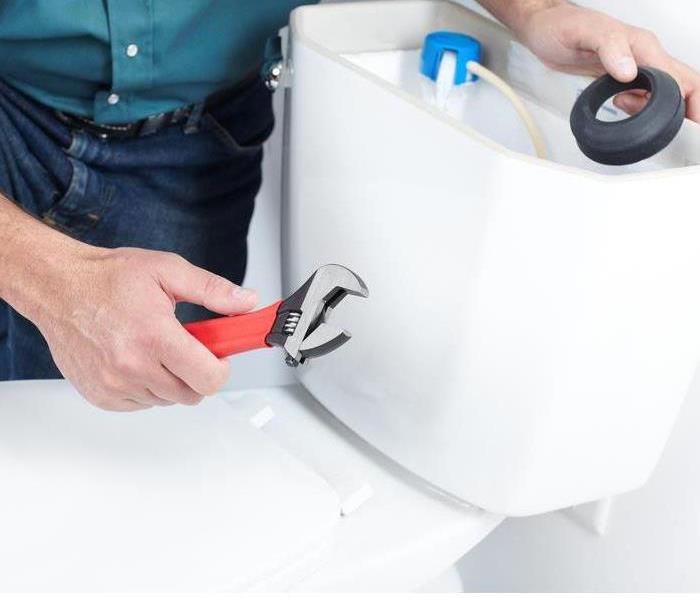 Catch your toilet leaking quickly to save yourself time and money
Catch your toilet leaking quickly to save yourself time and money
A leaking toilet at your home in Carpentersville, IL, is more than just a nuisance. It can cost you hundreds of dollars in water bills, create an unsightly environment in your bathroom and cause water damage in your bathroom floors. You can easily fix a bathroom leak by knowing where the leak is coming from, what is causing the leak and how to repair it.
Water Leaking From the Base of the Toilet
• When water pools on the floor near the bottom of the toilet, first try the simplest solution. Remove the caps and use a wrench to gently tighten the bolts that connect the toilet to the floor.
• If tightening the bolts does not work, you likely need to replace the wax ring seal. To accomplish this, remove the toilet. Once the toilet is out, replace the wax ring seal and reattach the toilet.
• If the flange under the wax seal is broken, you may need to seek professional help to replace it.
Water Leaking From the Bottom of the Tank
• Again, try tightening the tank bolts first. If this solves the leaking toilet, you just saved yourself a lot of work. If not, keep investigating.
• If the water shoots out from between the bowl and the tank every time you flush, likely the problem is the seal between the two. For repairs, drain the tank and disconnect it from the bowl. Remove the broken seal, install a new one and replace the tank.
When you catch a leaking toilet at your home in Carpentersville, IL, right away you save yourself time and money. If a bathroom leak is ongoing, such as from improper installation, you run the risk of increased water bills and floor rot underneath the toilet. If the floor is decaying from water damage, your home is at risk for numerous other problems, such as mold. In this case, it is in your best interest to immediately contact a water restoration specialist to assess the situation and properly repair the damage.
For more on Carpentersville click here.
Water Damage Precautions
6/20/2018 (Permalink)
When you have a water damage in your home there are some precautions you can take to keep your home from being damaged in the winter.
Some of the precautions and mitigation efforts you can undertake to prevent water damage caused by freezing are as follows:
- Set your thermostat to at least a 55% temperature during the day and night
- Drain and store your water hoses indoors after drying
- Drain the swimming pool and water supply lines as instructed
- Relocate pipes exposed to freezing and very cold air movement
- Insulate your plumbing fixtures with appropriate protections such as a pipe sleeve or heat tape
Although it is not winter yet, you should have these things in mind to keep your home from being damaged this winter. SERVPRO of East & West Dundee / SW Barrington Hills is Here to Help.
Four Tips for Water Damage
6/20/2018 (Permalink)
Homeowners can use these tips to help get their homes restored after a water damage problem. Understanding how water works during a loss will help in the mitigation process.
Four Tips for Water Damage
- How far did the water migrate? Water migrations helps the restoration company know how much material is wet and where to place equipment.
- What materials need to be dried? Air movement is added right away to materials that can bind water. Wood and drywall hold a lot of water and needs air movement.
- Is there visible mold? Air movement should not be applied to the home if there is visible mold.
- Where did the water come from? Depending on the source of water will depend on what materials can be restored. If the water came from a clean source then the drying is easier.
Answering these questions after calling SERVPRO of East & West Dundee/SW Barrington Hills can help determine how much damage will need to be cleaned.
Kitchen Rebuild
6/11/2018 (Permalink)
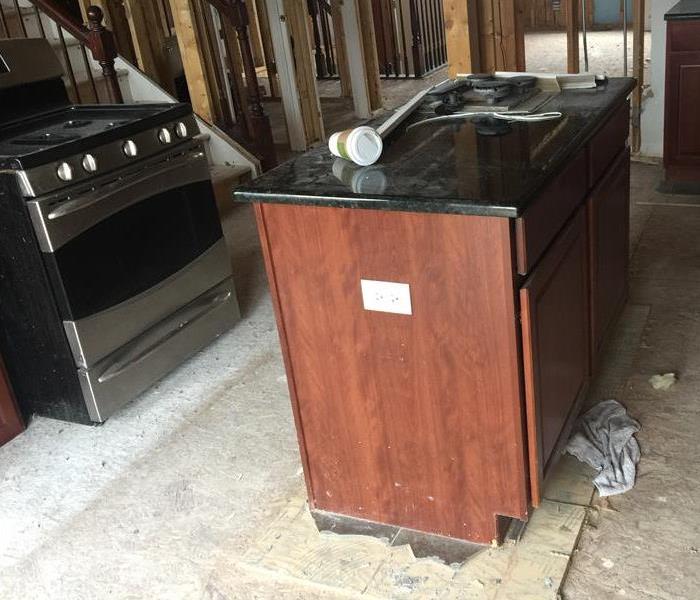 We can put it back too!!
We can put it back too!!
We certainly understand the devastation that a water loss can bring to you and your home or business. It is our goal to help you through the entire process. Our customers know that and after a pipe burst under the sink in their kitchen, this resident called SERVPRO of East & West Dundee / SW Barrington Hills.
After we removed the damaged materials and set the equipment to dry out the kitchen, the customer let us know that they then wanted us to do the "put back."
The customer was able to enjoy themselves while picking out new cabinets and flooring for their soon to be newly remodeled kitchen.
It didn't take our crews long before the customer was back in their home and using their kitchen to enjoy their family dinners once again.
Hardwood Floor Damage
6/11/2018 (Permalink)
The common way of thinking is that if a material gets wet, it should be thrown out. Did you know that if your hardwood floor gets wet, SERVPRO of East & West Dundee / SW Barrington Hills has specialty drying equipment to try to save it? It is our goal to save you money on the repair side of your claim so we will discuss with your insurance adjuster and try to save your floor before just deciding to rip it out.
If we can dry it properly in place, it may only require a new coat of stain to look as good as new.
In this case, we were able to get the homeowner's hardwood back to pre-existing condition and once again, we had very happy customers!
Fast Action Counts in Commercial Water Damage
4/25/2018 (Permalink)
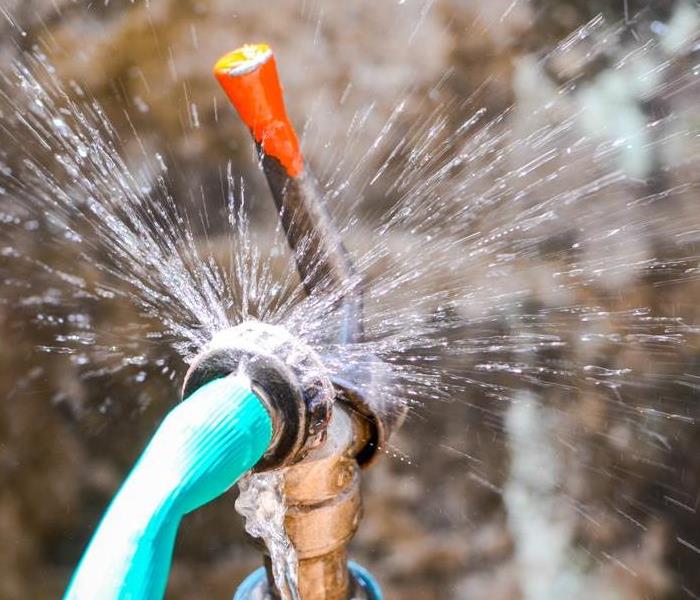 For your Commercial Water Loss contact SERVPRO
For your Commercial Water Loss contact SERVPRO
The risk of having your business closed down by disastrous water damage is usually directly reduced by having a plan of action in place. According to studies, up to 50 percent of businesses that experience such an event do not reopen. Most that do recover had a contingency plan ready to go. Here is how professional restoration services can help.
Keeping Damage to a Minimum
A commercial water mitigation and reconstruction professional should be ready and equipped to take quick action when water damage strikes, any hour of the day. You can reduce risk of major damage and make your own necessary steps easier by having an emergency profile in place. The profile is a collection of the information you need to move swiftly, contacting and informing your damage professional as soon as a situation occurs. The faster his or her response, the greater the likelihood that you can avoid serious damage to your building and equipment.
Planning for Safety and Success
A representative of your Gilberts, IL, franchise can help you collect the information for the emergency profile. This simple step can give you the following security advantages:
• A cost-free professional assessment that analyzes damage contingencies at your location
• A brief profile document that narrows down information to only what is needed in order to handle a water damage disaster
• A local professional who can serve as your water damage mitigation and restoration source
• A chain of command that can authorize repair work quickly, reducing response time to the emergency
• A guide that can help you get back into your building as soon as possible following a disaster
• A reference of such details as priority locations, shut-off valves, and urgent contact information, resulting in minimal time lost in dealing with your emergency
Your emergency profile can result in the least possible loss of time in dealing with your water damage event. For added protection, an ERP app typically allows you to undertake immediate action by phone or other wireless device. A commercial water damage specialist can tell you more.
Click here for more on Gilberts.
3 Safety Measures To Employ When Replacing a Toilet
3/29/2018 (Permalink)
When a toilet malfunctions in your Carpentersville, IL, home, you will probably want to take steps to fix it right away. A leaking toilet may be especially problematic because it can damage your floors and create the perfect environment for mold growth. If you need to replace your toilet, there are a few safety measures you can put in place for each step to keep yourself and your family safe.
1. Prepare the Area
Before you remove the toilet, preparing the area can prevent accidents before they start. Keep young children and curious pets away from the bathroom and have newspapers or a tarp handy to rest the toilet on once you remove it. Wear gloves and protective glasses and have a bucket within arm’s reach to prevent water spills during the toilet repair.
2. Inventory Your Tools
Removing your old toilet requires a few tools, including a scraper, wrench, pliers and a measuring tape. Collect all these tools ahead of time so you will not have to search for them during the repair process. When you use your wrench to loosen the bolts that hold the toilet to the floor, be sure no tools are scattered around before you attempt to lift the toilet and check the wax seal and flange, as stumbling during this phase could cause serious injury.
3. Avoid Touching Contaminated Water
A leaking toilet may cause contaminated water to puddle around the base or run across your bathroom floor if it should spill from the bowl or if it has previously overflowed. If this occurs, call a flood cleanup and restoration company to inspect and sanitize your bathroom to prevent damage to your floors and walls and to check for the presence of mold before you install the new toilet.
Replacing a leaking toilet at your Carpentersville, IL, home does not have to be difficult when you take the time to work safely. Making the right preparations, reading through directions before you begin and taking one step at a time can help keep this a safe and painless process.
Visit us at http://www.SERVPROeastwestdundeeswbarringtonhills.com for more information.

 24/7 Emergency Service
24/7 Emergency Service
